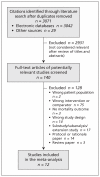Cardiac resynchronization therapy: a meta-analysis of randomized controlled trials
- PMID: 21282316
- PMCID: PMC3050946
- DOI: 10.1503/cmaj.101685
Cardiac resynchronization therapy: a meta-analysis of randomized controlled trials
Abstract
Background: Studies of cardiac resynchronization therapy in addition to an implantable cardioverter defibrillator in patients with mild to moderate congestive heart failure had not been shown to reduce mortality until the recent RAFT trial (Resynchronization/Defibrillation for Ambulatory Heart Failure Trial). We performed a meta-analysis including the RAFT trial to determine the effect of cardiac resynchronization therapy with or without an implantable defibrillator on mortality.
Methods: We searched electronic databases and other sources for reports of randomized trials using a parallel or crossover design. We included studies involving patients with heart failure receiving optimal medical therapy that compared cardiac resynchronization therapy with optimal medical therapy alone, or cardiac resynchronization therapy plus an implantable defibrillator with a standard implantable defibrillator. The primary outcome was mortality. The optimum information size was considered to assess the minimum amount of information required in the literature to reach reliable conclusions about cardiac resynchronization therapy.
Results: Of 3071 reports identified, 12 studies (n = 7538) were included in our meta-analysis. Compared with optimal medical therapy alone, cardiac resynchronization therapy plus optimal medical therapy significantly reduced mortality (relative risk [RR] 0.73, 95% confidence interval [CI] 0.62-0.85). Compared with an implantable defibrillator alone, cardiac resynchronization therapy plus an implantable defibrillator significantly reduced mortality (RR 0.83, 95% CI 0.72-0.96). This last finding remained significant among patients with New York Heart Association (NYHA) class I or II disease (RR 0.80, 95% CI 0.67-0.96) but not among those with class III or IV disease (RR 0.84, 95% CI 0.69-1.07). Analysis of the optimum information size showed that the sequential monitoring boundary was crossed, which suggests no need for further clinical trials.
Interpretation: The cumulative evidence is now conclusive that the addition of cardiac resynchronization to optimal medical therapy or defibrillator therapy significantly reduces mortality among patients with heart failure.
Figures




Comment in
-
Cardiac resynchronisation therapy reduces mortality in patients with heart failure but questions remain.Evid Based Med. 2012 Apr;17(2):42-3. doi: 10.1136/ebm-2011-100074. Epub 2011 Jul 7. Evid Based Med. 2012. PMID: 21742668 No abstract available.
-
Absolute risk reduction a must.CMAJ. 2011 Sep 20;183(13):1517-8; discussion 1519. doi: 10.1503/cmaj.111-2067. CMAJ. 2011. PMID: 21930749 Free PMC article. No abstract available.
References
-
- Johansen H, Strauss B, Arnold JM, et al. On the rise: The current and projected future burden of congestive heart failure hospitalization in Canada. Can J Cardiol 2003;19:430–5 - PubMed
-
- Pfeffer MA, Braunwald E, Moye LA, et al. Effect of captopril on mortality and morbidity in patients with left ventricular dysfunction after myocardial infarction. Results of the survival and ventricular enlargement trial. The SAVE Investigators. N Engl J Med 1992;327:669–77 - PubMed
-
- Effect of enalapril on mortality and the development of heart failure in asymptomatic patients with reduced left ventricular ejection fractions. The SOLVD Investigators N Engl J Med 1992;327:685–91 - PubMed
-
- The Cardiac, Insufficiency Bisoprolol, Study II. (CIBIS-II). a randomised trial. Lancet 1999;353:9–13 - PubMed
Publication types
MeSH terms
Grants and funding
LinkOut - more resources
Full Text Sources
Medical
